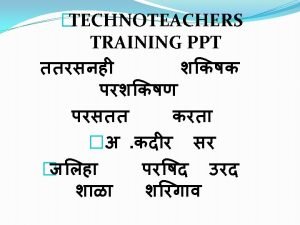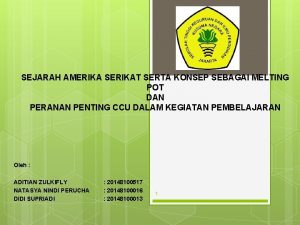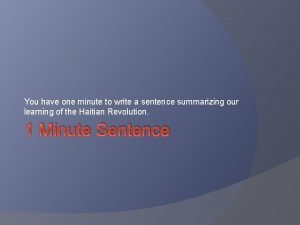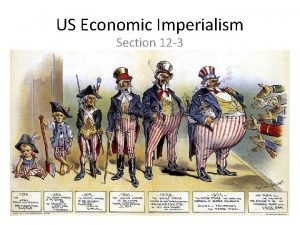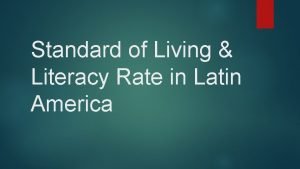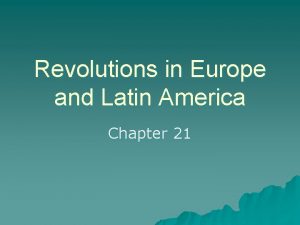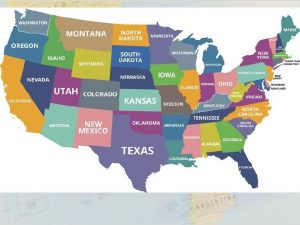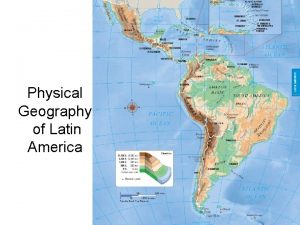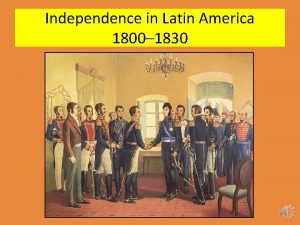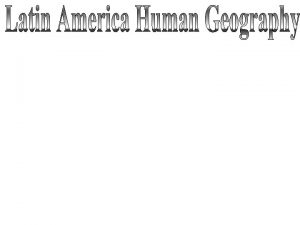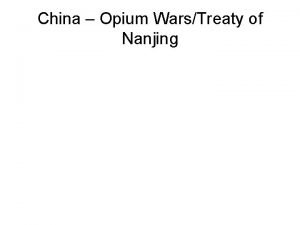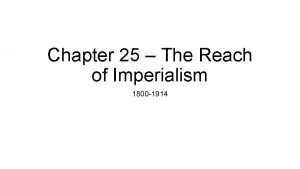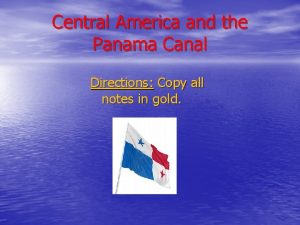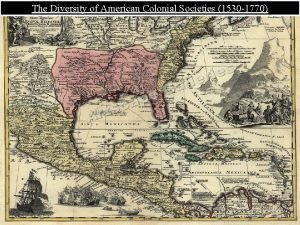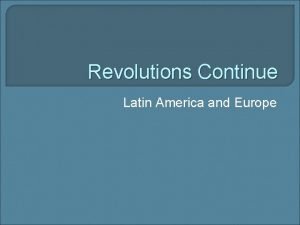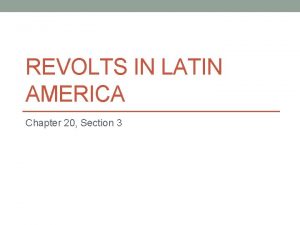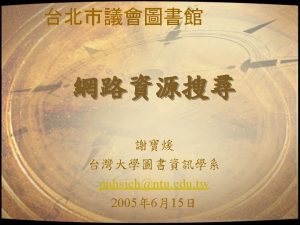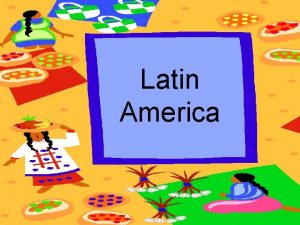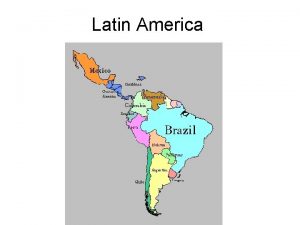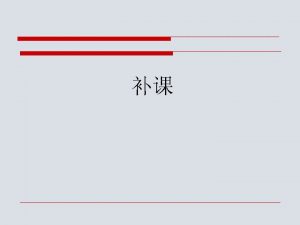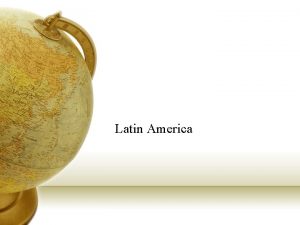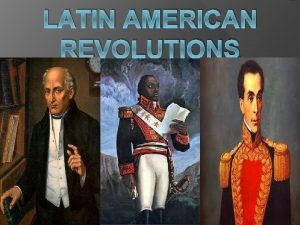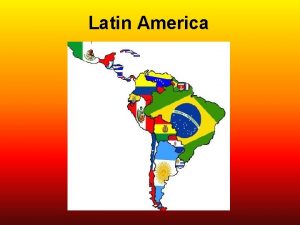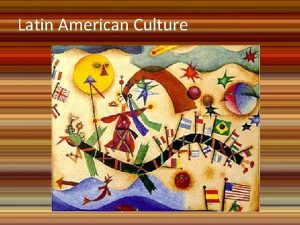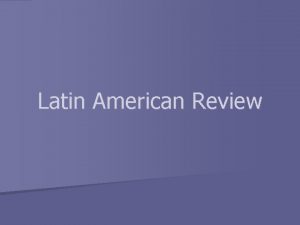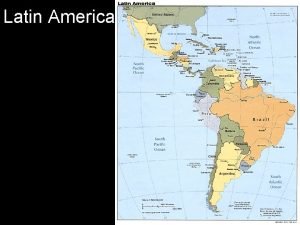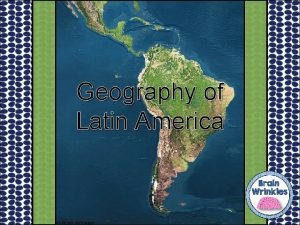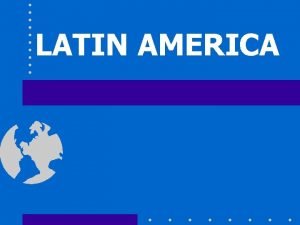Why is Latin America called Latin America Google
































- Slides: 32

Why is Latin America called Latin America? • • Google. com The nations in Latin America have been heavily influenced through colonialism by the Spanish, Portuguese, and French. These European nations were all heavily influenced by the Roman culture and the Latin language. The colonists brought their languages, religion, and traditions to the conquered nations. The name Latin America serves as a reminder to the cultural influences left by colonialism. 1

Today’s Issues: Latin America A colonial past has left Latin America with long-term problems, including environmental crises, political instability, and poverty. 2

Rainforest Resources • Special-interest groups make competing demands on the resources of the rainforest. • As the rainforests are destroyed, the quality of life on earth is threatened. Destination 360. com 3

Vanishing Biodiversity • Rain forest has biodiversity—wide range of plant, animal species. • 50 million acres of rainforest worldwide destroyed annually. Somervillepubliclibrary. org 4

Clearing the Rainforests • Mahogany and cedar are harvested, then exported from Amazon. • Poor native farmers clear rain forest for crops. • Poor soil fertility and increased erosion lead to more timber clearing Bbc. co. uk 5

Slash and Burn Farming Bbc. co. uk 6

The Price of Destruction: Losing More than Just Trees • Deforestation—cutting down and clearing away trees. • Rain forests regulate climate: absorb carbon dioxide, and produce oxygen. • Fewer forests mean less carbon dioxide is absorbed. It builds up in atmosphere, and prevents heat from escaping into space. • Global warming—atmospheric temperature rises, weather patterns may change. 7

Plants and Animals in Danger • The rainforest covers 6% of earth’s surface but has 50% of the earth’s plant and animal species. • Many medications come from plants found in the rainforest. Conservenature. org 8

Moving Toward Solutions: A Juggling Act • Balancing economic development with rainforest preservation. Some countries restrict economic development. • Grassroots organizations try to educate people about rainforests protest environmentally damaging plans. Rainforestconservation. org 9

Fighting Economics with Economics • One environmental plan is the debt-for-nature swap. This allows the groups to pay part of government’s large debt. • In return, the government protects part of rain forest. • This approach has worked in Bolivia. 10

Giving Citizens a Voice • Despite obstacles, democracy is beginning to succeed in Latin America. • The success of Latin American democracies depends on political, economic, • and social reforms. 11

The Legacy of Colonialism • Since Spanish conquest in 1500 s, Native Americans were ruled by others. • Under Spanish rule: governors ruled the region, acting on behalf of monarchs. • Minority of Spanish colonists still ruled after 1800 s independence. • Oligarchy—non-democratic government of the few • Press censored, free speech limited, dissent punished • Discrimination against those not in Spanish ruling class • elections were rigged 12

The Legacy of Colonialism History. com • If government couldn’t control people, military would seize power and form a junta— harsh government run by generals. 13

The Rule of the Caudillo • Many 20 th-century Latin. American countries ruled by a caudillo, military dictator or political boss, such as Argentina’s Juan Peron. • They were supported by the military and wealthy population; sometimes even elected Nndb. com 14

The Rule of the Caudillo • Partido Revolucionario Institucional (PRI) ruled Mexico for 71 years. In English, the Institutional Revolutionary Party. • Opposition parties legalized, and elections held. Fraud and corruption keep PRI in power. • Opposition parties make gains in 1997 congressional elections. • Vicente Fox becomes first non-PRI president in 2000. • In 2010 the president was Felipe Calderon. • Current president is Enrique Peña Nieto. Therightperspective. org 15

The Goals of Reform • Establish constitutional government, democracy. Freely elected government that respects the law. • Citizens participate in political affairs. • Citizens are well-educated and economically secure. • Economic stability needed for political stability. 16

Establishing Stable Democracies: The Goals of Reform • In 1983 Raul Alfonsín becomes president of Argentina. • First free election in decades, but economy was ruined by military rule. • To fight inflation (rise in prices) Alfonsín freezes wages, prices issues new currency to replace peso (which later returned). • Measures work at first, but by 1989 inflation was back. • Carlos Menem elected as new president; introduced capitalist reforms • Reduces government spending; sells off state industries, utilities. 17

The Goals of Reform • Increase women’s role in politics, involvement in government. • Marta Suplicy elected mayor of São Paulo, Brazil, in 2000. Dasartes. com 18

Land Reform • Land reform—break up ruling minority’s large landholdings • take land, economic power from wealthy elite, give to peasant farmers • Mexican land reform begins when Benito Juarez becomes president in 1858 – wanted to redistribute land to break cycle of poverty • Further land reform follows Revolution in early 20 th century 19

How can the economic gap between rich and poor be bridged? 20

The Income Gap • Income gap—the difference between quality of life for rich and poor • Rio de Janeiro’s mix of wealth, poverty illustrates an income gap • Some people live in swamps, garbage dumps; others live in luxury • The gap is widening in Latin America; solutions have been proposed 21

Bridging the Gap Between Rich and Poor • Income gap—difference between quality of life of the rich and poor • Gap is widening in most Latin American countries • Gap has many causes, including the impact of colonialism • Three ways to understand the issue: moral, economic, political 22

A Moral Issue • How can a caring society justify wealthy few, poor majority? • Catholic Church, other religious faiths see problem as moral. Some feel narrowing gap is matter of social justice. 23

An Economic Dilemma • Most countries have free-market economies, minimal government rules. • People have freedom, rewards they need to create wealth. • Poor communities lack skills to fully, equally participate in such an economy. • Most have little education; can’t read, can’t find jobs. • End up doing menial labor. • Conditions in slums bring disease, crime, short life spans. Istockphoto. com 24

A Political Problem • Poverty creates desperation people with nothing to lose are willing to take risks. • They protest, fight, attempt to overthrow unjust governments, societies. • Region has had many bloody rebellions put down by militaries • Argentina, Bolivia, Brazil, Columbia, El Salvador, Guatemala during civil wars, human rights and dignity are violated. • Rebels seek economic justice, militaries protect wealthy 25

Education, Politics, and Economics • Gap varies by country. • 45% of Brazilians live in poverty. • Income gap is much narrower in Ecuador, Paraguay, Uruguay. • Governments hope free-market economies will narrow gap. • Create economic opportunity, stability for all citizens. 26

Education, Politics, and Economics • Democracy seen as essential for widespread prosperity. • Provides outlet for protest, opposition. • Policies can reflect will of people. • Important to spend money on education. • Need literate, well-educated people for complex economy’s new jobs 27

Population Distribution in Latin America Tropical climates throughout the Caribbean promote agriculture that can support large populations. A dry climate and desert areas in northern Mexico are less populated than the more tropical zones in the South. Amazon Rainforest The coastal Atacama desert and the Andes Mountains make the western side of South America a less desirable place to live. Columbia. edu In Brazil, most people prefer to live in the coastal areas than in the inland Rainforest areas. Humidity is high in the rainforest and land must be cleared before farming can occur. 28

Natural Disasters • The Caribbean is the most tourism-dependent region in the world. The threat of hurricanes can have serious consequences for the region’s tourism industry. • Latin America is also a region that is frequently victim to earthquakes. – Buildings must be built to withstand, earthquakes, strong winds and flooding rains. – Special insurances can be purchased for crops to protect farmers from hurricanes. – In some areas, there are no building codes or insurances to protect people from natural disasters. Disastersafety. org 29

Latin American Drug-Trade The flow of drugs from South and Central America into the United States: Earththreats. com 30

Latin American Drug Trade • South America (mostly Colombia) is the number one producer of heroin in the western hemisphere. • 60 -65% of all Latin American drugs are sold in the United States. • Damaging to the economies of Latin American countries because drug use increases health care costs, and the government must pay officers to patrol and try to prevent drug trafficking. 31

Bibliography • Mcdougal Littell, World Geography. Houghton Mifflin Company. 2012 32
 Why is it called latin america
Why is it called latin america Why why why why
Why why why why Creat google forms
Creat google forms Why is america called a melting pot
Why is america called a melting pot Dont ask why why why
Dont ask why why why Add calendar to google forms
Add calendar to google forms Google earth google prevoditelj
Google earth google prevoditelj Https//scholar.google.com.br
Https//scholar.google.com.br Google docshttps://mail.google.com/mail/u/0/#inbox
Google docshttps://mail.google.com/mail/u/0/#inbox America america you mean the world to me
America america you mean the world to me Asia europe north america
Asia europe north america Repetition in let america be america again
Repetition in let america be america again Eu amo a américa e a américa me ama
Eu amo a américa e a américa me ama The jazz style called swing flourished in america from
The jazz style called swing flourished in america from Penisulares
Penisulares Economic imperialism definition
Economic imperialism definition What is the literacy rate in latin america
What is the literacy rate in latin america Revolutions in europe and latin america section 1 quiz
Revolutions in europe and latin america section 1 quiz Physical feature of latin america
Physical feature of latin america Physical geography of latin america worksheet answers
Physical geography of latin america worksheet answers Griffin ford latin american model
Griffin ford latin american model Trade barriers comic strip
Trade barriers comic strip South america webquest
South america webquest Latin america hierarchy
Latin america hierarchy Political and physical features of latin america
Political and physical features of latin america Largest economy in latin america
Largest economy in latin america Berlin conference scramble for africa
Berlin conference scramble for africa Plateau of mexico
Plateau of mexico The reach of imperialism vocabulary activity
The reach of imperialism vocabulary activity Latin america acrostic poem
Latin america acrostic poem Caste system in latin america
Caste system in latin america Peninsulares creoles mestizos
Peninsulares creoles mestizos Discontent in latin america worksheet answers
Discontent in latin america worksheet answers


